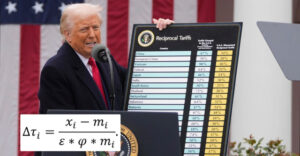The mathematical formula used by the Trump administration to calculate the “retaliatory” tariffs contains a serious mathematical error that significantly overstates the actual impact by about four times, according to economists at the American Enterprise Institute.
As Axios.com reports, this think tank, according to the American Enterprise Institute, instead of calculating the tariffs correctly, ended up imposing them much higher than needed to achieve US policy goals.
After the announcement of the tariffs last Wednesday, the government published a complicated formula that it said it developed with the cooperation of the Council of Economic Advisers.
In essence, the formula is nothing more than the US trade deficit with each country divided by the value of goods imported from that country. Two more variables in the equation cancel each other out and become practically meaningless.
That is, in simpler words:
The formula used calculated “the elasticity of import prices with respect to tariffs” i.e. the effect of tariffs on the price of imported goods. However, the Trump administration used an elasticity value of 0.25, which according to economic theory means that the effect of the tariff on the import price is limited. Economists, however, argue that the wrong value was used. The correct value would be 0.945, which indicates that almost all of the tariff directly affects the import price.
Decisions and controversy
Economists point out that it is contradictory to combine two different types of elasticity in the equation, as has been done by the Trump administration. As they explain, these formulas do not complement each other and should be used separately. If the Trump administration had used the correct value for the elasticity, the tariff imposed on countries like Vietnam would have been 12.2%, not 46% as it was eventually applied.
The US Trade Representative’s Office (USTR) backed up its calculations with research by Professor Alberto Cavallo of Harvard Business School. However, Cavallo himself said it is unclear whether his findings were used correctly. Nevertheless, the USTR continues to support its approach.
Accordingly, Corinth and Veuger conclude that the formula used by the Trump administration has no basis in economic theory or commercial law. However, if it is considered a serious foundation for US trade policy, then responsible officials should ensure that the calculations are properly applied.
Ask me anything
Explore related questions





